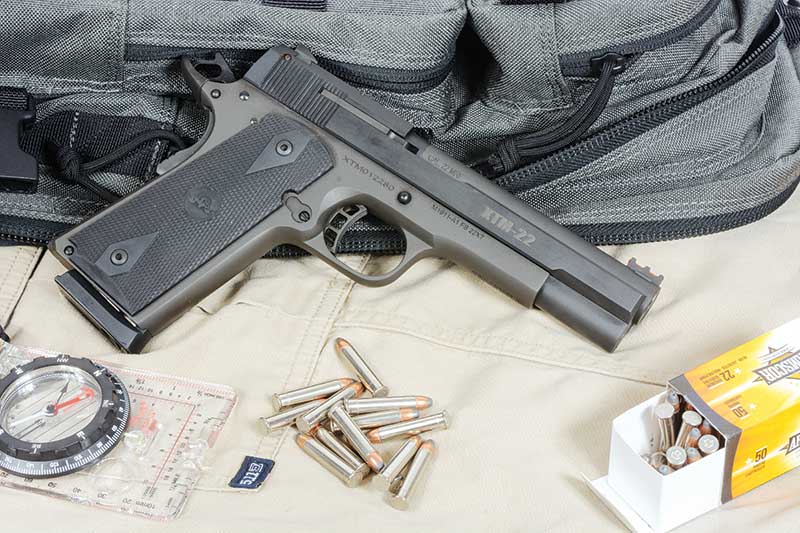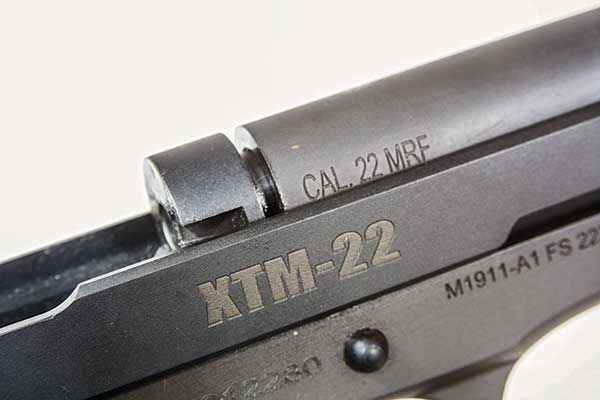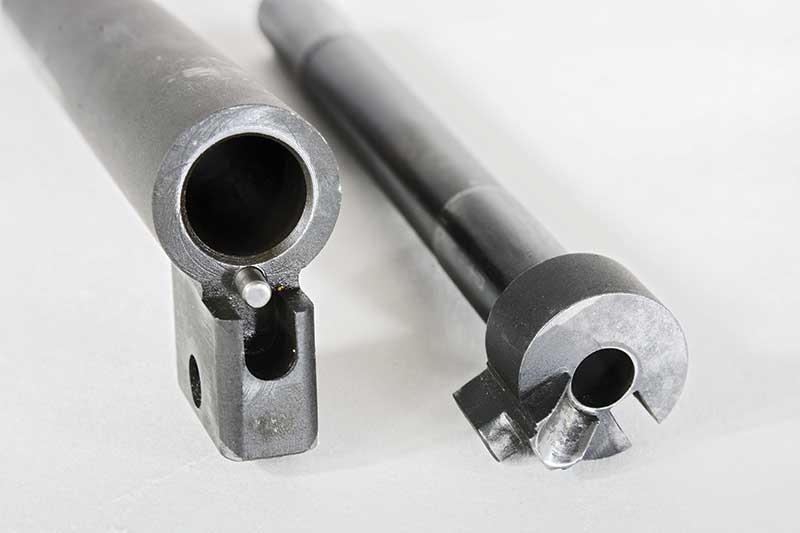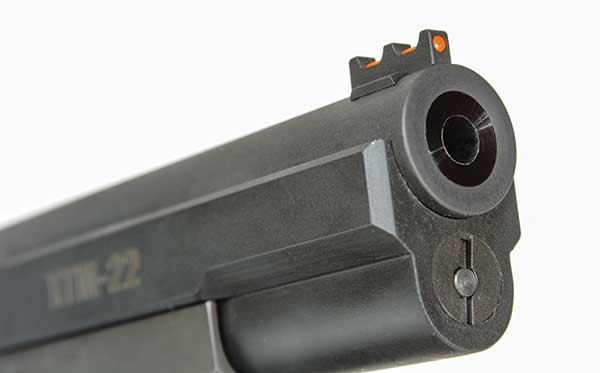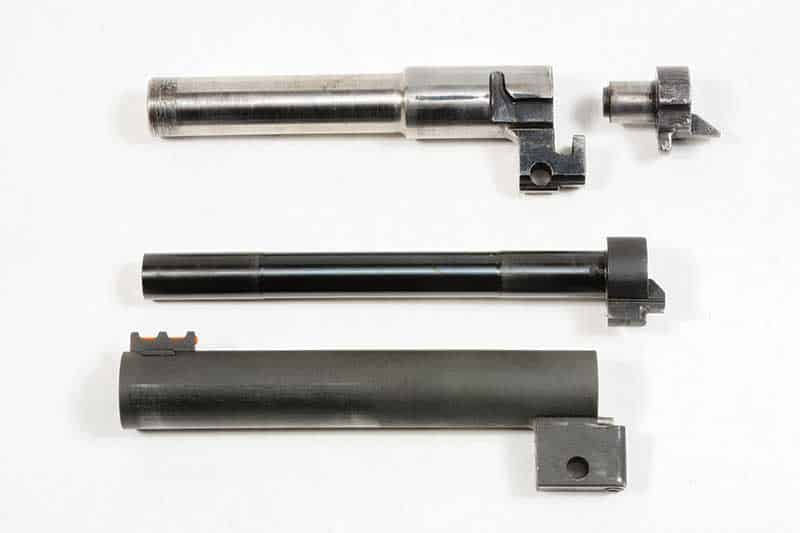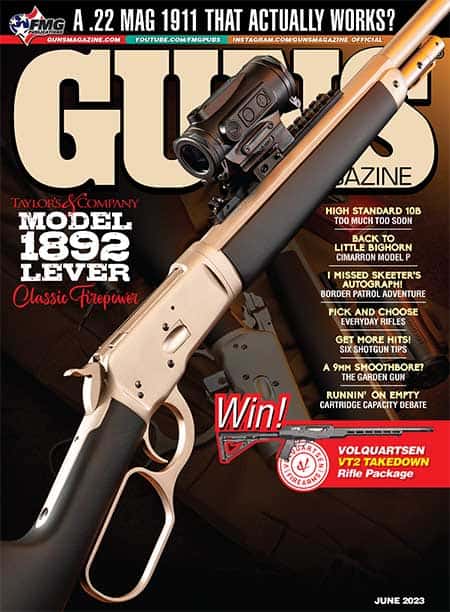Rock Island Armory
XT22 Magnum 1911
'Unique' Is Only The Start!
Rock Island has a well-earned reputation for guns punching above their weight class and for unexpected innovation. Their .22 TCM, a shortened .223 round adapted to a double-stack 1911 platform, easily rivals the performance of the 5.7×28 in a far less expensive package. Not only is the cartridge good, but the Rock Island pistols I’ve shot it in functioned flawlessly and produced groups that could hurt the feelings of many more expensive handguns.
The Long Wait
With this background, it’s perhaps not surprising they have released a long-awaited .22 Magnum model. If you’re wondering “long awaited by who?” Well, that would at least be me — I was going back and forth with one of the major conversion makers about doing one over 20 years to no avail and was thrilled when Rock Island confided they were working on one. The prototype I shot several years ago worked just fine, but the production XT is a more sophisticated and better gun clearly benefitting from the added maturation.
If you think there’s something a little unusual about a semiauto pistol in .22 Magnum, you’d be right because only a handful have ever been made. The genre started in 1987 with the AMT Automag II. Three years later came the short-lived Grendel P-30, which lasted until 1994, followed in the mid-aughts by Excel Arms who offered the Accelerator pistol and, at the time, a long-slide 1911-style .22 Magnum. None achieved major popularity until Kel-Tec’s PMR30 appeared in 2010. Walther’s WMP has appeared on the scene only recently.
This small handful of Magnum autopistols actually gets a little smaller. When I first encountered Excel at SHOT many years ago, the rep I spoke with had formerly worked on the Automag and some of its design elements had been carried over to the new pistol. Similarly, the Grendel was the brainchild of Swedish gun designer and later Kel-Tec founder George Kellgren (“Kel-Tec” and “Grendel” now make sense to me), and the PMR30 is loosely based on his earlier design. This developmental evolution basically halves the number of people who have ever been able to get a .22 Magnum to market.
The Basic Problem
There’s a good reason for this — it’s hard to make one work. The .22 WMR (Winchester Magnum Rimfire) is a long, thin, straight-walled cartridge, which is about the worst thing for something that has to be fed at an angle. If I’m reading the SAAMI standards correctly, it shares the same 24,000 PSI maximum pressure as the .22 LR, but does it with a lot more velocity, some 500 fps or more in some loads. The same force pushing the bullet out one end of the barrel is trying to do the same thing to the spent casing at the other end, and this is the second part making .22 Magnums hard.
The .22 LR pistols are blowback, which means the weight of the slide/bolt and the force of the recoil spring provide adequate resistance to keep the action closed until chamber pressures have dropped enough the empty brass can safely be extracted. If the gun opens up too fast, the pressure splits the brass case to send brass fragments, burned powder and other debris through whatever opening it can find — often down the mag well or through the ejector slot in the slide. I’ve experienced this with a 9mm and a .45 and have the x-rays to prove it. It is no bueno.
The other problem resulting from the gun opening up when chamber pressure is still too high is the elevated chamber pressure holds the expanded case tightly against the chamber walls, making it impossible to extract. This is why roller-locked guns such as the MP5/G3 family have fluted chambers: The flutes redirect gas to the outside of the case to equalize the pressure inside and outside the casing, “floating” it up off the chamber walls so it can be extracted. That solution has been tried before on .22 Mag pistols, as have small ports drilled forward of the chamber to bleed off pressure. The XT, however, brilliantly repurposes the floating chamber Colt previously adopted to solve the opposite problem of insufficient chamber pressure on .22 LR 1911 pistols.
Invented by David “Carbine” Williams, then doing hard time in a North Carolina prison camp for the murder of a revenue agent, the floating chamber is a short little chamber insert recoiling separately from the barrel. It gives enough quick punch to get the full-sized steel slide of Colt’s ACE pistol moving, in spite of the otherwise inadequate recoil of the .22 LR. The XT has a similar insert, except it runs the full length of the barrel. The external “barrel” you see is a fixed sleeve in which the insert moves forward and back. Where the small, light floating chamber enhanced recoil, the added mass of this system dampens it, absorbing recoil energy. A spring briskly pops the insert into the rearward feed position as soon as the slide is opened.
This isn’t the only change required to make the Magnum work in a 1911 package. A seasoned hand will feel the slight difference in width front-to-rear where the frame has been stretched to accommodate the 1.35″-long WMR. By comparison, the .45 ACP around which the 1911 was designed has a maximum overall length of 1.275″. The proprietary magazine holds 14 rounds, which is also a bit of an engineering feat when you consider the difficulty of making rimmed cartridges stack on top of one another.
Everything else about the gun is straight 1911. Available either with a barrel-mounted rail for those wishing to use an optic, or iron sights in either fixed or adjustable configuration, my test gun is the fixed-sight version with a dovetailed fiber optic front and drift-adjustable rear. The hammer is the familiar oval-slotted one, which my digital Lyman scale tells me drops crisply with 3 lbs., 15 oz. of pressure on the skeletonized black trigger equipped with the familiar overtravel screw.
Safeties consist of an upswept beavertail with a grooved speed bump and standard-length thumb safety, while grips are rubber panels with molded-in double diamond checkering.
The Big Reveal
Now, after all the talk of how hard it is to make a .22 Magnum work, on to the real question. Yes, it works, and it hits. I fired over 500 rounds of various .22 mag ammo through it with good results. While the magazine springs were pretty stiff at first, they quickly loosened up so the gun could hold a full load of 14+1.
At first, I neither cleaned nor oiled the XT as is my usual practice, and everything ran except for Winchester 40-grain Super X FMJ, which lacked sufficient power to adequately cycle the slide and would often trap a spent case in the action. After a few hundred rounds, the gun got a little sluggish so I oiled it and the problems went away — and, indeed, even the previously problematic Winchester rounds cycled well. This could be considered a worthwhile lesson about making sure a new gun is properly lubricated!
Accuracy was good. I managed 25-yard groups in the inch-and-a-half range by resting my hands and the XT was great fun on steel. It was a little hard to hear the ping from so far away, but shooting at 80 yards alongside a friend we managed enough near-full-mag consecutive hits to know any misses were our fault.
In addition to the higher velocities, one advantage of the Magnum is it uses real-deal jacketed bullets as opposed to the copper-washed projectiles loaded in the .22 LR. This opens up a variety of options, from full-metal-jacket projectiles to hollow points like the Gold Dot and Hornady ballistic tips.
I was recently in an event at Gunsite Academy focusing on survival handguns and the .22 LR pistol won a resounding victory. While .22 Magnum ammo will never be quite as plentiful as LR, the weight is similarly light and the extra power is an advantage. I plan to hunt hogs during our state’s small game season, where the calibers are strictly limited and feel much better about shooting something tusked with a .22 Magnum instead of an LR.
A 15-shot Magnum makes a compelling argument for itself in either the survival or small game hunting roles, or just for enjoyable shooting. Rock Island’s XT will do all of it well.
MSRP: $599
RockIslandArmoryUSA.com
